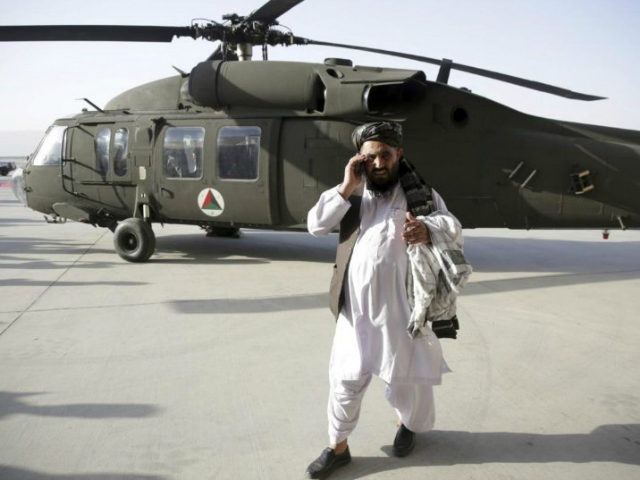The much-needed “tidal wave of air power” that a U.S.-supplied fleet of 159 new Black Hawk helicopters is expected to bring to the Afghan military’s war against the Taliban and other jihadists will not be fully operational until 2022, reports the Washington Post (WaPo).
“Getting the aircraft is just the head of the snake. That’s the easy part. The hard part to get is the tail of the snake — training pilots and flight crews, doing maintenance and finding parts,” Col. Darryl Insley, deputy commander of the U.S. air advisory program, told the Post.
The newspaper acknowledges that the Trump administration has made the development of a capable Afghan Air Force, including the Black Hawk program, a top priority.
WaPo continues:
Yet officials of the U.S. air training, advising and assistance mission here said they expect to have only four Afghan flight crews ready for conflict missions by the next spring’s fighting season and 32 teams and Black Hawks ready by spring 2019. The full fleet of 159 choppers will not be in place and manned until 2022, and only 58 will be equipped with attack weapons.
During a ceremony marking the delivery of the new aircrafts in early October, American Gen. John Nicholson, the top commander of U.S. and NATO forces, said the helicopter fleet would enhance the Afghan National Defense and Security Force’s (ANDSF) ability to take on the enemy.
He vowed that “a tidal wave of Afghan airpower is on the horizon” in the war against Taliban jihadists “and there is no stopping it. ”
“This is the beginning of the end for the Taliban,” he later added.
However, the Post learned from U.S. military officials that it will take longer than expected for the Black Hawk program to fully contribute to the overall wartime “asymmetric advantage” of Afghan military air power as expected.
WaPo acknowledges that “constraints of time, language, delivery, maintenance and on-the-job pilot training” are presently getting in the way of progress within the Afghan air force, noting:
The versatile, hardy U.S. Army aircraft, each costing more than $7 million to refurbish and deliver, are intended to gradually replace the Afghan fleet of Soviet-era Mi-17 choppers to carry out military cargo drops, troop transport, and medical evacuations. But they are already coming late to the game, a drawback aggravated by the slow pace of UH-60 deliveries, the limit of six Afghan pilots in each three-month training course, and the need to keep the Mi-17 choppers in action in the meantime.
Meanwhile, the Taliban continues to conquer territory, and the Islamic State (ISIS/ISIL) branch in Afghanistan keeps expanding its influence. Both groups are contributing to the deteriorating security conditions in Afghanistan that are expected to carry on into next year.
A capable Afghan Air Force is critical to U.S. President Donald Trump’s strategy. Trump’s plan is largely focused on an ANDSF-led effort to defeat ISIS and pressure the Taliban into a peace agreement with the Kabul government.
“Afghan field commanders have said that more efficient air combat, rescue, and resupply support is urgently needed to motivate troops and push back the insurgents,” reports the Post.
Despite $70 billion of the nearly $877 billion in direct war spending that the United States has spent since 2001 on developing the ANDSF, the force continues to suffer from capability lapses, in large part, attributed to the nascent Afghan Air Force.
The U.S. Special Inspector General for Afghanistan Reconstruction (SIGAR), a watchdog agency, and other analysts have identified the reasonably young Afghan Air Force as a major obstacle to a capable ANDSF, which includes police and army units.
A fully operational and efficient Afghan Air Force is vital for the ANDSF to be able to protect Afghanistan and maintain battlefield gains on its own.

COMMENTS
Please let us know if you're having issues with commenting.